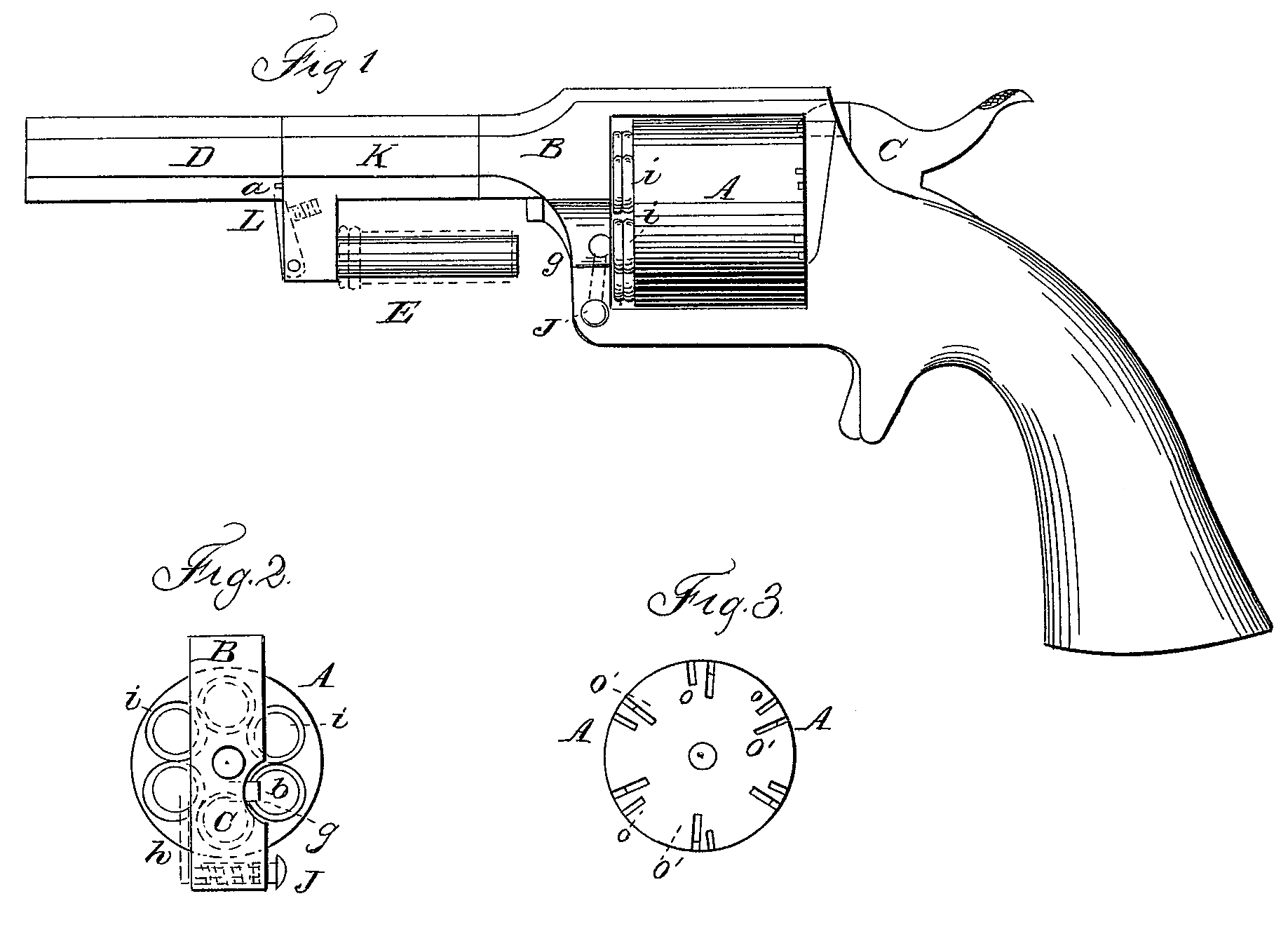US 47775
UNITED STATES PATENT OFFICE.
JOHN H. WICKERS, OF WORCESTER, MASSACHUSETTS, ASSIGNOR TO HIMSELF AND LUCIUS. W. POND, OF SAME PLACE.
IMPROVEMENT IN REVOLVING FIRE-ARMS.
Specification forming part of Letters Patent No. 47,725, dated May 16, 1865.
To all whom it may concern:
Be it known that I, John H.Wickers, of the city and county of Worcester, State of Massachusetts, have invented certain new and useful Improvements in Fire-Arms; and I do here by declare the following to be a full, clear, and exact description of the construction and operation of the same, due reference being had to the accompanying drawings.
Figure 1 represents a side view of a revolving pistol to which my improvements are applied. Fig. 2 represents the front end of the revolving breech-cylinder and adjacent parts. Fig. 3 represents the rear end of the same.
To enable others skilled in the art to make and use my invention, I will proceed to describe its construction and operation.
A represents the revolving breech-cylinder, B the frame of the pistol, D the barrel, and C the hammer. i represents the thimbles, which are inserted into the chambers of the cylinder A, and in using metal cartridges the charges are inserted into said thimbles, the objects of the thimbles being to facilitate the removing of the cartridge-shells after the charge is fired.
E represents a stem whose diameter is equal to the inner diameter of the thimbles i. It is attached to the barrel D by means of the sleeve K, and can be turned thereon; but it can also be secured in its position to be either in line with the chamber b or with the chamber c, Fig. 2, of the cylinder A. In the former case the thimble of the chamber b can be pushed upon the stem E after the charge has been fired, and the stem E forces the empty cartridge-shell from within the thimble. The space between the end of the stem E and the face of the cylinder A must be sufficiently large to permit of the insertion of the loaded cartridges into the chambers of the cylinder A when each is successively brought into the position of chamber b. When the stem E is turned so as to be in line with the chamber c the thimbles can be removed from the cylinder A and from the piece, if it is desired to clean them, without removing the cylinder A. In Fig. 1 one of the thimbles (shown in red lines) is represented on the stem E.
g represents a stud, which is secured to the angular spring-rod h, whose lower end is provided with a small knob, J, which, on being pressed inward, causes the stud g to move in ward, as shown by red lines at Fig. 2. The object of the stud g is to prevent any accidental displacement of the thimble when its chamber is in the position of chamber b, Fig. 2, as in this position the thimble is not retained in its chamber by any part of the frame B, as is the case in any other position, and when the thimble is to be pushed upon the stem E the knob J is pressed inward and the stud g releases the thimble.
O’ represents the notches in the rear face of the cylinder A, through which the front end of the hammer C passes to explode the cartridges.
O represents another series of notches, which are made on the rear face of the cylinder A in such a position that the latter is locked by the front edge of the hammer at a point when the chamber l of the cylinder comes to the position where the loaded cartridge can be inserted, thus making the cylinder, self-adjusting and greatly facilitating the operation of loading. These notches serve at the same time to lock the hammer to prevent the accidental discharge of the piece when it is not to be used; but their principal use being the setting of the cylinder A for charging, their location is not discretionary, but for that purpose must be at certain points.
Having thus fully described the nature of my invention, what I claim herein as new, and desire to secure by Letters Patent, is—
The application to the barrel of revolving fire-arms of a hinged stem, E, for supporting the thimble and clearing it when removed from the cylinder A, substantially as and for the purposes described.
JOHN H. WICKERS.
Witnesses:
Isaac Davis,
Caleb Dana.

